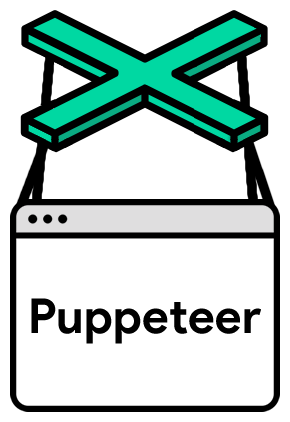
Employee Spotlight
From Academia to Industry
Philipp Burckhardt recounts his journey from childhood computer fascinations, to building an e-learning platform at Carnegie Mellon University, and on to his current role at Socket.
puppeteer
Advanced tools
Package description
Puppeteer is a Node library which provides a high-level API to control Chrome or Chromium over the DevTools Protocol. It is primarily used for automating web browser actions, such as taking screenshots, generating pre-rendered content, and automating form submissions, among other things.
Web Scraping
Puppeteer can be used to scrape content from web pages by programmatically navigating to the page and extracting the required data.
const puppeteer = require('puppeteer');
(async () => {
const browser = await puppeteer.launch();
const page = await browser.newPage();
await page.goto('https://example.com');
const data = await page.evaluate(() => document.querySelector('*').outerHTML);
console.log(data);
await browser.close();
})();Automated Testing
Puppeteer can automate form submissions and simulate user actions for testing web applications.
const puppeteer = require('puppeteer');
(async () => {
const browser = await puppeteer.launch();
const page = await browser.newPage();
await page.goto('https://example.com/login');
await page.type('#username', 'user');
await page.type('#password', 'pass');
await page.click('#submit');
// Check for successful login
await page.waitForSelector('#logout');
await browser.close();
})();PDF Generation
Puppeteer can generate PDFs from web pages, which is useful for creating reports, invoices, and other printable documents.
const puppeteer = require('puppeteer');
(async () => {
const browser = await puppeteer.launch();
const page = await browser.newPage();
await page.goto('https://example.com', {waitUntil: 'networkidle2'});
await page.pdf({path: 'example.pdf', format: 'A4'});
await browser.close();
})();Screenshot Capture
Puppeteer can take screenshots of web pages, either of the full page or specific elements, which is useful for capturing the state of a page for documentation or testing.
const puppeteer = require('puppeteer');
(async () => {
const browser = await puppeteer.launch();
const page = await browser.newPage();
await page.goto('https://example.com');
await page.screenshot({path: 'example.png'});
await browser.close();
})();Playwright is a Node library to automate the Chromium, WebKit, and Firefox browsers with a single API. It is similar to Puppeteer but adds support for multiple browser types and has additional features like network interception.
Selenium WebDriver is one of the most well-known browser automation tools. It supports multiple browsers and languages, making it more versatile than Puppeteer, but it can be more complex to set up and slower in execution.
Nightmare is a high-level browser automation library. It is simpler and has a more fluent API compared to Puppeteer, but it is less actively maintained and lacks some of the newer features that Puppeteer provides.
WebdriverIO is a custom implementation for selenium's W3C webdriver API. It is designed to be more accessible than the Selenium WebDriver and integrates well with modern web and mobile application testing practices.
Readme

Puppeteer is a Node.js library which provides a high-level API to control Chrome/Chromium over the DevTools Protocol. Puppeteer runs in headless mode by default, but can be configured to run in full (non-headless) Chrome/Chromium.
Most things that you can do manually in the browser can be done using Puppeteer! Here are a few examples to get you started:
To use Puppeteer in your project, run:
npm i puppeteer
# or `yarn add puppeteer`
# or `pnpm i puppeteer`
When you install Puppeteer, it automatically downloads a recent version of
Chromium (~170MB macOS, ~282MB Linux, ~280MB Windows) that is
guaranteed to work
with Puppeteer. For a version of Puppeteer without installation, see
puppeteer-core.
Puppeteer uses several defaults that can be customized through configuration files.
For example, to change the default cache directory Puppeteer uses to install
browsers, you can add a .puppeteerrc.cjs (or puppeteer.config.cjs) at the
root of your application with the contents
const {join} = require('path');
/**
* @type {import("puppeteer").Configuration}
*/
module.exports = {
// Changes the cache location for Puppeteer.
cacheDirectory: join(__dirname, '.cache', 'puppeteer'),
};
After adding the configuration file, you will need to remove and reinstall
puppeteer for it to take effect.
See the configuration guide for more information.
puppeteer-coreEvery release since v1.7.0 we publish two packages:
puppeteer is a product for browser automation. When installed, it downloads
a version of Chromium, which it then drives using puppeteer-core. Being an
end-user product, puppeteer automates several workflows using reasonable
defaults that can be customized.
puppeteer-core is a library to help drive anything that supports DevTools
protocol. Being a library, puppeteer-core is fully driven through its
programmatic interface implying no defaults are assumed and puppeteer-core
will not download Chromium when installed.
You should use puppeteer-core if you are
connecting to a remote browser
or managing browsers yourself.
If you are managing browsers yourself, you will need to call
puppeteer.launch with
an an explicit
executablePath
(or channel if it's
installed in a standard location).
When using puppeteer-core, remember to change the import:
import puppeteer from 'puppeteer-core';
Puppeteer follows the latest maintenance LTS version of Node.
Puppeteer will be familiar to people using other browser testing frameworks. You launch/connect a browser, create some pages, and then manipulate them with Puppeteer's API.
For more in-depth usage, check our guides and examples.
The following example searches developers.google.com/web for articles tagged "Headless Chrome" and scrape results from the results page.
import puppeteer from 'puppeteer';
(async () => {
const browser = await puppeteer.launch();
const page = await browser.newPage();
await page.goto('https://developers.google.com/web/');
// Type into search box.
await page.type('.devsite-search-field', 'Headless Chrome');
// Wait for suggest overlay to appear and click "show all results".
const allResultsSelector = '.devsite-suggest-all-results';
await page.waitForSelector(allResultsSelector);
await page.click(allResultsSelector);
// Wait for the results page to load and display the results.
const resultsSelector = '.gsc-results .gs-title';
await page.waitForSelector(resultsSelector);
// Extract the results from the page.
const links = await page.evaluate(resultsSelector => {
return [...document.querySelectorAll(resultsSelector)].map(anchor => {
const title = anchor.textContent.split('|')[0].trim();
return `${title} - ${anchor.href}`;
});
}, resultsSelector);
// Print all the files.
console.log(links.join('\n'));
await browser.close();
})();
1. Uses Headless mode
Puppeteer launches Chromium in
headless mode.
To launch a full version of Chromium, set the
headless
option when launching a browser:
const browser = await puppeteer.launch({headless: false}); // default is true
2. Runs a bundled version of Chromium
By default, Puppeteer downloads and uses a specific version of Chromium so its
API is guaranteed to work out of the box. To use Puppeteer with a different
version of Chrome or Chromium, pass in the executable's path when creating a
Browser instance:
const browser = await puppeteer.launch({executablePath: '/path/to/Chrome'});
You can also use Puppeteer with Firefox Nightly (experimental support). See
Puppeteer.launch for
more information.
See
this article
for a description of the differences between Chromium and Chrome.
This article
describes some differences for Linux users.
3. Creates a fresh user profile
Puppeteer creates its own browser user profile which it cleans up on every run.
See our Docker guide.
See our Chrome extensions guide.
Check out our contributing guide to get an overview of Puppeteer development.
FAQs
A high-level API to control headless Chrome over the DevTools Protocol
The npm package puppeteer receives a total of 3,058,050 weekly downloads. As such, puppeteer popularity was classified as popular.
We found that puppeteer demonstrated a healthy version release cadence and project activity because the last version was released less than a year ago. It has 2 open source maintainers collaborating on the project.
Did you know?

Socket for GitHub automatically highlights issues in each pull request and monitors the health of all your open source dependencies. Discover the contents of your packages and block harmful activity before you install or update your dependencies.

Employee Spotlight
Philipp Burckhardt recounts his journey from childhood computer fascinations, to building an e-learning platform at Carnegie Mellon University, and on to his current role at Socket.

Security News
Git dependencies in open source packages can introduce significant risks, including lack of version control, stability issues, dependency drift, and difficulty in auditing, making them potential targets for supply chain attacks.

Security News
Node.js has added experimental support for TypeScript, a move that highlights the growing importance of TypeScript in modern development.